American Sabbatical 033: 10/16/96
Olympus
10/16.. Olympus
Last night it snowed hard in the Cascades and dusted the Olympic Mountains. At 10AM when we rolled onto
the Hayuk, the Puget Sound ferry from Edmonds to Kingston, there
was still a bite in the breeze, and murky clouds were dodging
among the peaks. The tourist season is definitely over in the
northwest. As the ferry approached the slip at Kingston the tops
of the Seattle skyscrapers we had just departed poked their shining
heads above the smutch far to the southwest, and in response the
Olympic Mountains stood clear and sparkling above the darkgreen
hills before us. They sure know how to put on a show in these
parts, tourists or no.
Our ambition was to stand on the northwest corner of the contiguous
U.S., to be upwind of the lot of you. We had a loaf of fresh bread
and a hunk of cheese from Seattle, a thermos full of hot tea,
and our inertial guidance set for WEST one last time.
The road from Kingston to Flattery Bay makes an end run north
around the big peaks, but it can’t avoid the tall timber. Folks,
I’ve run out of large words. The trees out here leave me beyond
adjectives, and we haven’t gotten to redwood country yet. But
if the standing wood is humongous, the stumps tell of bygones
beyond bodacious. These venerable old ghosts loom up in the second
growth like tales of a lost kingdom.
| And the war against majesty goes on. The timber company signs
brag about regrowth and longterm cycles of harvesting, but the
scalped hills whisper another story, and the creeks are clogged
with mud. We drove through immense clearcuts running over the
mountains like a barber’s clippers at boot camp.Nowadays, after
harvesting machines skin the beast, the big diggers go through
and grub up the roots and stumps, and mound them up to burn. (On
level ground.. on the slopes the slash just erodes downhill.)
No doubt this is to hasten reseeding, but it creates a vision
of Armageddon. |
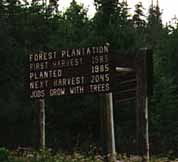
Timber Co. Propaganda
|
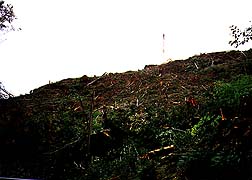
Logging Show
|
Logging isn’t pretty, they say, but that doesn’t mean it’s environmentally
destructive. Well, it’s hard to convince me that stripping thousands
of acres of vegetation, and leaving scorch and burn is a healthy
methodology. Profitable, no doubt, efficient, and a magnificent
image of industrial power, but disturbing to the innocent eye.
Is liquidation by the square mile a sound longterm strategy? I
can’t answer the question about healthy renewability in the woods,
but the old giants are gone, and the soaring firs of today are
rolling out of the Olympics on 34-wheelers in convoys. Faster
than replacement? Fast enough to be spooky when they come round
the hairpins at you. |
The north road along the peninsula angles down to the shore in
serpentine jigs, and a panoramic view of Vancouver Island marches
along opposite, across the Strait of Juan De Fuca. Big freighters
and tugs towing container-barges move along like cutouts in front
of the dark hills of Canada. The waterfront in Seattle was ajump
with shipping, and here it was, streaming to and fro. We stopped
along the shore and walked the tidewrack, at home in the ammonia
and seafleas. Same old shuck and gurgle, round stones and gluey
seaweeds. And the same old limited access. Private no entry signs
posted and roads to the shore all no trespassing. Only where the
road skirts the beach can you go dabble your feet, and then you
have to turn a blind eye to the signage.
The farther out the peninsula we went, the more it felt like backcountry
Maine. The clearcuts came down to the road (it’s hard to hide
the nakedness of such towering hills with a beauty-strip, anyhow),
the pickups got more beatup, and the dooryards started looking
like the stumpyards.. all ahoo. These provinces where resource
harvesting reigns all have the same tagsale ambiance. It’s up
for grabs, boys, better get yours. And I feel curiously at home
in this atmosphere. All the boys in gotohell hats and rubber boots
meeting you eyetoeye and returning the highsign. A nod, a hand
gesture. Everyone watching carefully for signs of economic opportunity,
or a story to tell. I could slide in here easy as butter, and
get rancid just as quick. I was vaguely uncomfortable in the disinterested
self-absorption on Galiano, and in bland Vancouver. Seattle was
too urban in its defensive avoidance and disengagement, but the
bitter end of the Olympics has nothing to hide, and no facade
to hide it behind.
| The end of the line, Neah Bay, has a Coast Guard detachment and
a Native American Reservation, sort of like Jonesport. While Peggy
went into the local museum, I frigged with the car radio which
had decided to go into permanent scan mode. A flock of crows hopped
and croaked around me looking for castoffs. I threw them radio
parts. Then a bald eagle swooped the scene and lit in a big Doug
fir about 30 yards uphill. I broke out the binocs and eyeballed
him for half an hour. We are honored with eagles on the home coast.
Welcome to the other end of America. |
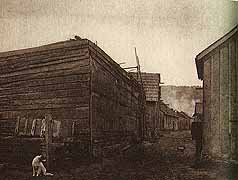
Makah Village
(Edward Curtis)
|
After Peggy did her research thing we tried to drive to the absolute
edge, but the road to Flattery Point was washed out. The Indians
gathering mushrooms down the mudrun told us where to get a roadside
view of Ultima Thule, but that was beyond the power of Red Owl,
too. So we made do with a long pan down the west coast of Olympia,
with monolithic sandstones standing waistdeep in the Pacific rollers,
and headlands receding into a blue haze. We stopped along the
gravel track to watch a black-tailed deer, entranced by an Indian
whistling from her truck, nodded at a black grouse walking the
shoulder, slowed down for the loose remuda of horses, and shared
a wave with some net fishermen in the tidal marsh by the road.
The background hills were stripped bare, and one was being mined
for roadfill. The natives are into extraction up to their elbows,
but the animals still come to their call. We hightailed it out,
before we started making deals and bogging down.
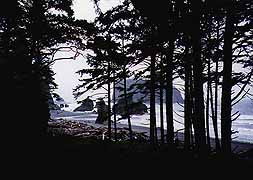
Pacific Shore
|
We hauled into the Salmon Smoker Restaurant in Forks, Washington
at famished time, and inhaled two fetuccini with smoked salmon,
clam chowder and a salad. The apple-rhubarb pie was excellent.
Now we’re booked into an overpriced motel (a seller’s market at
sunset on the backside of the Olympics), only to find it has a
whiny dialtone. So there’ll be no e-mail tonight. Sleep tight,
amigos. |
(Memo #31)
Oct .17 - MAKAH FIRST PEOPLE
WHO? Makah Tribe
WHAT? Reservation, community at Neah Bay, tribal museum
WHERE? Cape Flattery, the most northwest corner of Olympic Peninsula
in Washington State, on Strait of Juan de Fuca
WHEN? prehistoric sites to present-day communities
HOW? the Makah have a mixed economy with a strong dependence on
the sea
Topics: Native Americans, Northwest coast cultures, Olympic peninsula,
federal Indian policy. |
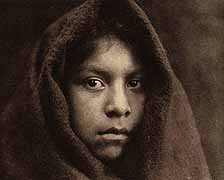
Makah Maiden
(Edward Curtis)
|
|
Questions: What are the most recently created mountains in the
world?
How is Pompeii like Ozette village and how did both challenge
archaeologists? How was the Ozette site used in court on the Makah’s
behalf? |
|
The native people of the area we visited today ate shellfish,
collected seagull eggs, hunted whales, and wove cedar bark cloth.
Their culture shows us again how incredibly varied the cultures
of Pre-Columbian peoples were in North America.
Puget Sound is separated from the Pacific Ocean by the huge wild
Olympic Peninsula (about 90 miles miles east to west and about
100 miles long). The Strait of Juan de Fuca which connects the
ocean to Puget Sound is the northern boundary, with Vancouver
Island across it (mountains on the horizon). Several large bays
punctuate the Pacific coast of the peninsula and the Columbia
River to its south forms the southern border of the state of Washington.
The Olympic Mountains, which geologists say are the newest mountains
in the world, are at the center of the peninsula and of the national
park it contains. Theodore Roosevelt set aside much of the Olympic
Peninsula as park land during his presidency and an elk species
found here was named in his honor. This glorious wilderness is
a short ferry ride and drive from Seattle. Once again I feel lucky
to be traveling off season since there is one main road that circles
the peninsula. A few logger and park roads penetrate the interior
and it’s foot travel in to the high mountains from there.
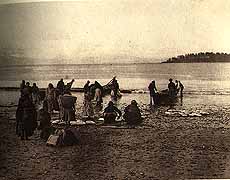
Halibut Fishermen Landing
(Curtis)
|
We drove across the top of the Olympic Peninsula to Cape Flattery,
the most northwestern point in the contiguous states. Right there
is the Makah Reservation centered on the community of Neah Bay.
Makah apparently is shorthand for “ people who are generous with
food”, a title their neighbors gave them. Their name for themselves
means “people who live by rocks and seagulls”. Theirs was a northwest
coast culture with a stronger ocean emphasis. The art, food, ritual
are very like those of other groups to the north (Tsimshian, Tlingit,
Haida etc.). The Makah hunted, gathered and fished traditionally,
taking whales and seals and fish, berries and roots. |
Living by the entrance to the strait, the Makah were contacted
by the earliest European explorers. This provided access to trade
goods and lead to decimation from European diseases (down to 654
people in 1861). In 1855 a treaty reduced tribal landholdings
from 700,00 to 28,000 acres, and the Makah are still located on
these ancestral lands. The Indian New Deal in the 1930’s made
possible self-rule under a five-person tribal council. Neah Bay
today resembles many coastal villages. The main road hugs the
harbor. The Makah live in trailers and ranch houses and bungalows.
The village has its own stores, school, medical and veterinary
clinics, several churches, a town hall, the tribal offices and
a wharf. The harbor, protected by a long breakwater, supports
a year-round multi-species fishery. The tribe practices sustained
yield forestry on its land. Cedar trees are set aside for crafts.
Makah children were getting home from school when we drove in,
toting backpacks and books. We got directions from a Makah teenager
with streaked hair and a skateboard, and from a Makah woman in
a Chevy van who had just been out to collect wild mushrooms.
| In 1970, coastal erosion uncovered part of the five hundred year
old Makah village of Ozette buried centuries ago by a mudslide.
Archaeologists were called in . The mud covering required new
techniques with a prosaic tool, the garden hose. Wet artifacts
had to be carefully hosed off, cataloged, removed and dried and
coated (they used PEG - polyethylene glycol). The excavations
uncovered huge numbers of artifacts and structures and this lead
to the creation of a tribal museum. The excavation also had legal
implications since evidence of nets and net fishing were found
at Ozette. This means that this technology was “traditional” according
to federal law and must be allowed today. We saw Makah men setting
nets in a stream. |
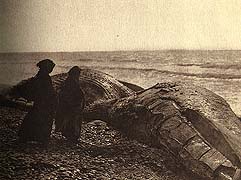
Makah and Whales
(Curtis)
|
Ozette artifacts are housed in the Makah Culture and Research
Center. This small museum has some gems. One exhibit shows the
work of Young Doctor, a Makah businessman and carver of the late
1800s. He was conscious of the loss of ritual and songs and set
out to learn old ones and create new ones, a distinctive form
of self-preservation. One of the most interesting artifacts was
a woven doghair and woodpeckerfeather blanket in a plaid. Dogs
apparently were bred by the Makah in Pre-Columbian times for long
hair that would spin and weave well. Other textiles (for clothes
and hats and mats) were made from cedar bark fiber and various
plants (bear grass, sitka sedge etc). Baskets and wooden boxes
created from a single plank provided storage and containers. Food
was even cooked in boxes and baskets by filling them with liquid
or “mush” into which hot rocks, moved by tongs, were thrust.
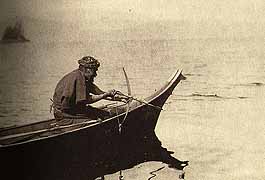
Sea Otter Hunting
(Curtis)
|
The museum contains an entire longhouse (about 20’ X 40’) from
the Ozette site. It is eerie and moving to enter a traditional
First Nation house. We’ve been in several museums that contain
homes and furnishings and they have enormous impact: the Mitchell
Prehistoric site museum had a semi-subterranean house, the Vancouver
museum had several houses outside. The Makah house has huge posts
and beams. To create the walls, planks were attached to upright
poles by looped ropes which allowed the plank siding to be moved
if the residents wanted cross-ventilation. Planks formed the roof.
|
There were several areas in the house for different families distinguished
by fires on the earthen floor and partial partitions. Benches
covered with furs were the beds and chairs. Goods were suspended
from beams. Makah goods were highly ornamented with the stylized,
heavily outlined abstracts of men and animals and supernatural
beings that are similar to the art of other northwest coast people.
The museum has a wonderful collection, but has been hampered in
its education work by cuts in federal funding. We left the village
feeling that the Makah have fused old and new into a vibrant culture.







